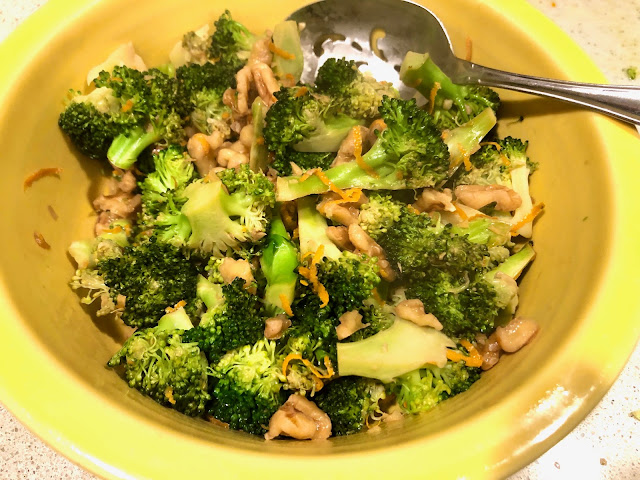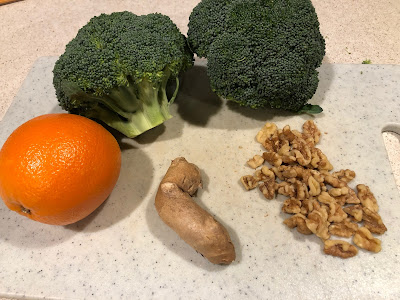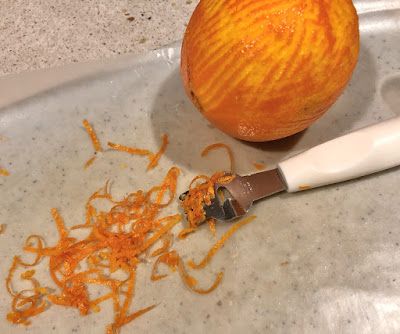
Recipe: Broccoli side dish is quick and delicious
 |
| Broccoli can be bright and fresh, really. (Photos: Kathy Morrison) |
Oranges and other citrus are a godsend in winter, when we need a dash of brightness, both in color and flavor. They're great in baked goods and salads, of course, but also in vegetable dishes, where the orange adds highlights without bumping up the calorie count.

|
This broccoli dish comes from a favorite source, "The Sunset Cookbook," the big one with the orange cover, published in 2010. The editors credit a reader, Laura A. Flynn, for creating this side, which speaks so much of California cooking: a few fresh seasonal ingredients, a little Asian influence and a light hand in the cooking. It's ready in less than 10 minutes once the ingredients are prepped. Keep the broccoli pieces fairly small so they cook quickly and the broccoli remains bright green.
Orange and walnut broccoli
Adapted from "The Sunset Cookbook"
Serves 4 to 5
Ingredients:
1 large navel orange
1 tablespoon vegetable oil
1/2 cup chopped walnuts
1/2 teaspoon minced fresh ginger
1 tablespoon soy sauce
5 cups (12 ounces) broccoli florets, cut in bite-size pieces (some stem is OK, but not wide pieces)
Black pepper, optional
Instructions:

|
|
.
|
Zest the orange using a citrus zester (see photo) or grater, being careful not to grate the white pith as well. A Microplane zester can be used, but the orange zest will be much smaller -- the larger strips are ideally what you want in this dish.
Juice the orange and reserve 1/4 cup juice; save the rest for another use.
Heat oil in a wok or slope-sided sauté pan over medium-high heat. Stir-fry the zest, walnuts and ginger just until the edges of the zest ares lightly brown, about 2 minutes.
Stir in the 1/2 cup orange juice and the soy sauce. Add the broccoli florets and cook, stirring occasionally, until the florets are just tender, about 5 minutes.
Season with freshly ground pepper, if desired, and serve.
Comments
0 comments have been posted.Sacramento Digs Gardening to your inbox.
Sites We Like
Garden Checklist for week of April 21
This week there’s plenty to keep gardeners busy. With no rain in the immediate forecast, remember to irrigate any new transplants.
* Weed, weed, weed! Get them before they flower and go to seed.
* April is the last chance to plant citrus trees such as dwarf orange, lemon and kumquat. These trees also look good in landscaping and provide fresh fruit in winter.
* Smell orange blossoms? Feed citrus trees with a low dose of balanced fertilizer (such as 10-10-10) during bloom to help set fruit. Keep an eye out for ants.
* Apply slow-release fertilizer to the lawn.
* Thoroughly clean debris from the bottom of outdoor ponds or fountains.
* Spring brings a flush of rapid growth, and that means your garden is really hungry. Feed shrubs and trees with a slow-release fertilizer. Or mulch with a 1-inch layer of compost.
* Azaleas and camellias looking a little yellow? If leaves are turning yellow between the veins, give them a boost with chelated iron.
* Trim dead flowers but not leaves from spring-flowering bulbs such as daffodils and tulips. Those leaves gather energy to create next year's flowers. Also, give the bulbs a fertilizer boost after bloom.
* Pinch chrysanthemums back to 12 inches for fall flowers. Cut old stems to the ground.
* Mulch around plants to conserve moisture and control weeds.
* From seed, plant beans, beets, cantaloupes, carrots, corn, cucumbers, melons, radishes and squash.
* Plant onion sets.
* In the flower garden, plant seeds for asters, cosmos, celosia, marigolds, salvia, sunflowers and zinnias.
* Transplant petunias, zinnias, geraniums and other summer bloomers.
* Plant perennials and dahlia tubers for summer bloom.
* Mid to late April is about the last chance to plant summer bulbs, such as gladiolus and tuberous begonias.
* Transplant lettuce seedlings. Choose varieties that mature quickly such as loose leaf.